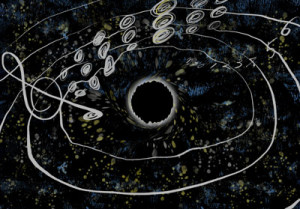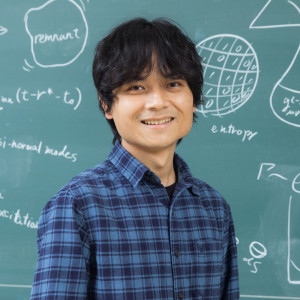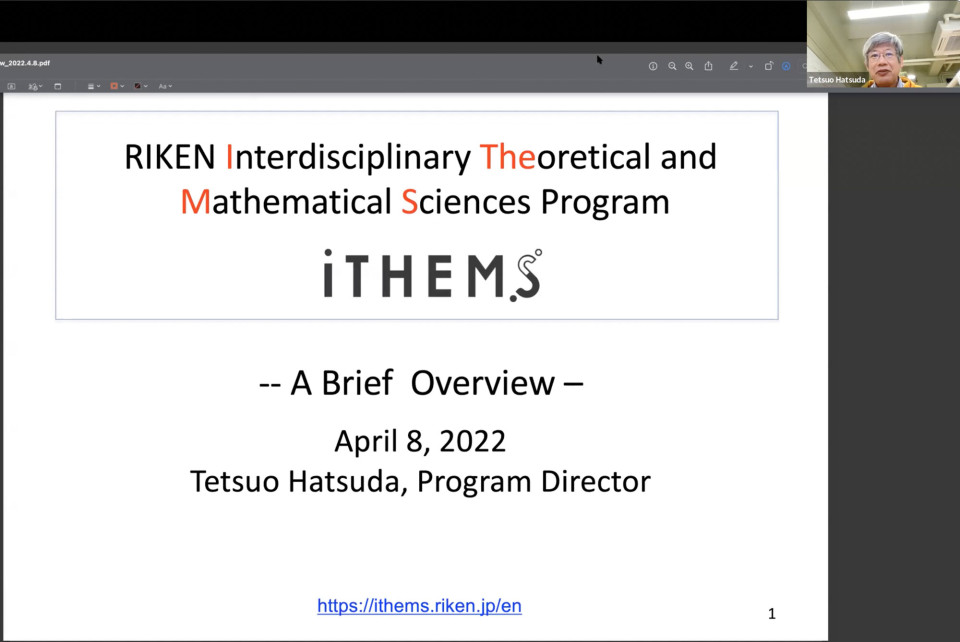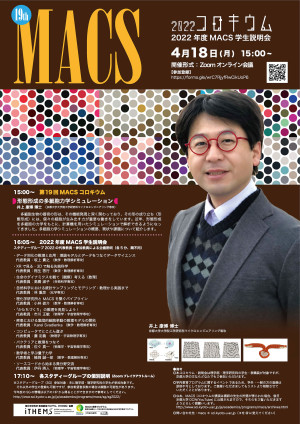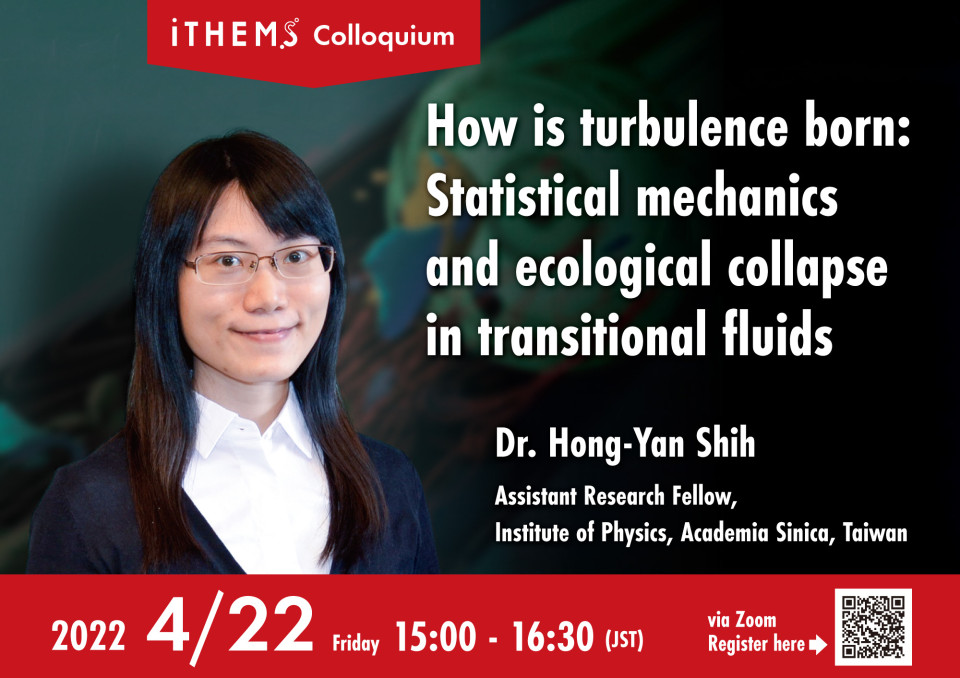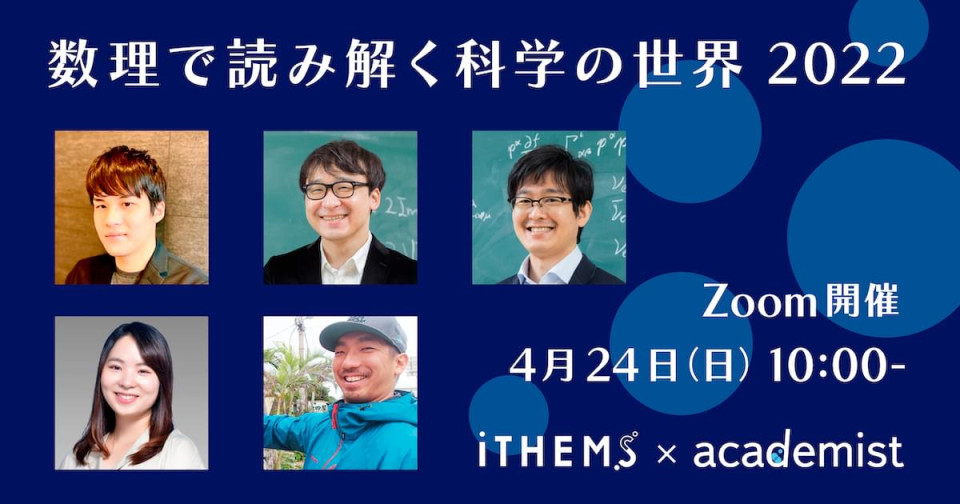Volume 194
Back to Newsletter List
Research News
RIKEN Research: Ringing black holes could put general relativity to the test
2022-04-08
Typical overtone chords in the gravitational waves produced when black holes collide could be used to test general relativity, a mathematical analysis by a RIKEN physicist has shown [1].
When black holes merge, they generate gravitational waves, which ripple outward like sound waves from a ringing bell. In theory, these gravitational waves can be broken down into tones and overtones—like in music—based on their different frequencies and the rate at which they dampen and die out. But in practice, gravitational-wave detectors are not yet sensitive enough to definitively pick up the overtones.
However, cosmologists are keen to measure the precise oscillation pattern because it can tell them more about a black hole’s properties. In particular, the mass of the black hole and the rate at which it is spinning can be calculated from the damping rate and frequency.
“It’s like when you hear an instrument, you can understand if it is a guitar or a piano,” says Naritaka Oshita of the RIKEN Interdisciplinary Theoretical and Mathematical Sciences Program (iTHEMS).
To read more, please visit the related link.
Reference
- Oshita, N, Ease of excitation of black hole ringing: Quantifying the importance of overtones by the excitation factors, Physical Review D 104, 124032 (2021), doi: 10.1103/PhysRevD.104.124032
Hot Topic
iTHEMS Starter Meeting for FY2022 on April 8, 2022
2022-04-11
The iTHEMS Starter Meeting for FY 2021 was held over Zoom as past two years’ meeting to kick off its activity for FY 2022. Over seventy iTHEMS members, frequent visitors and colleagues from other institute got together and introduced each other.
iTHEMS Starter Meeting for FY2022
April 8 (Fri) 12:30 - 14:00, 2022
Seminar Report
iTHEMS Biology Seminar by Dr. Hiroshi Yokota on April 14, 2022
2022-04-14
In iTHEMS biology seminar on April 14th, I introductory talked about the coarse-grained molecular dynamics simulation by using Langevin equation which is the equation of motion including the interaction, the friction and the random force. First, I mentioned the chromosome formation dynamics as an example of the application range of the simulation. Next, I explained the Langevin equation and its intuitive picture. Then, I showed the discretized Langevin equation which keeps the stochastic properties of the random force term. Finally, I showed some examples of Langevin simulation. Many questions and discussions arose from the audience. Thank you very much!
Coarse-grained molecular dynamics simulation via Langevin simulation
April 14 (Thu) 10:00 - 11:00, 2022
Upcoming Events
Colloquium
MACS ColloquiumSupported by iTHEMS
The 19th MACS Colloquium
April 18 (Mon) 15:00 - 17:40, 2022
Yasuhiro Inoue (Professor, Department of Micro Engineering, Graduate School of Engineering, Kyoto University)
15:00- The 19th MACS Colloquium: Talk by Prof. Yasuhiro Inoue "Multicellular Dynamics Simulation of Morphogenesis"
16:05- MACS SG information session
17:10- Individual explanation by each study group (Zoom breakout room)
Venue: via Zoom
Event Official Language: Japanese
Seminar
NEW WG Seminar
Light-matter control of quantum materials: From light-induced superconductivity to cavity materials
April 20 (Wed) 15:30 - 17:00, 2022
Michael Sentef (Emmy Noether Research Group Leader, Max Planck Institute for the Structure and Dynamics of Matter, Germany)
In this talk I will discuss recent progress in controlling and inducing materials properties with light [1]. Specifically I will discuss recent experiments showing light-induced superconductivity through phonon driving in an organic kappa salt [2] and its possible theoretical explanation via dynamical Hubbard U [3]. I will then highlight some recent theoretical and experimental progress in cavity quantum materials [4], where the classical laser as a driving field of light-induced properties is replaced by quantum fluctuations of light in confined geometries. Ideas and open questions for future work will be outlined.
References
- A. de la Torre, D. M. Kennes, M. Claassen, S. Gerber, J. W. McIver, M. A. Sentef, Colloquium: Nonthermal pathways to ultrafast control in quantum materials, Rev. Mod. Phys. 93, 041002 (2021), doi: 10.1103/RevModPhys.93.041002
- M. Buzzi, D. Nicoletti, M. Fechner, N. Tancogne-Dejean, M. A. Sentef, A. Georges, M. Dressel, A. Henderson, T. Siegrist, J. A. Schlueter, K. Miyagawa, K. Kanoda, M.-S. Nam, A. Ardavan, J. Coulthard, J. Tindall, F. Schlawin, D. Jaksch, A. Cavalleri, Photo-molecular high temperature superconductivity, Phys. Rev. X 10, 031028 (2020), doi: 10.1103/PhysRevX.10.031028
- J. Tindall, F. Schlawin, M. Buzzi, D. Nicoletti, J. R. Coulthard, H. Gao, A. Cavalleri, M. A. Sentef, D. Jaksch, Dynamical Superconductivity in a Frustrated Many-Body System, Phys. Rev. Lett. 125, 137001 (2020), doi: 10.1103/PhysRevLett.125.137001
- Frank Schlawin, Dante M. Kennes, Michael A. Sentef, Cavity Quantum Materials, Applied Physics Reviews Reviews 9, 011312 (2022), doi: 10.1063/5.0083825
Venue: via Zoom
Event Official Language: English
Lecture
Introduction to Topological Insulators: From Quantum to Classical Physics 3
April 21 (Thu) 15:00 - 17:00, 2022
Tomoki Ozawa (Associate Professor, Advanced Institute for Materials Research (AIMR), Tohoku University)
In this set of lectures, I give an introduction to topological insulators. A goal is to provide an overall understanding of basic concepts of the physics of topological insulators to mathematicians and physicists with no prior knowledge on the subject. Very roughly speaking, topological insulators are materials whose wavefunctions show nontrivial topological structure in momentum space. Materials with topologically nontrivial wavefunction in momentum space have been found to host modes which are localized at the surface (edge) of the material: a property known as the bulk-edge correspondence. The bulk-edge correspondence results in experimentally observable signature of somewhat abstract notion of topology of the wavefunction in momentum space. Originally, topological insulators were found and studied for electrons in solid-state materials, which are quantum mechanical. However, certain properties of topological insulators, including the bulk-edge correspondence, have been found to hold also for purely classical materials, such as electromagnetic waves obeying Maxwell’s equations, or waves described by Newtonian mechanics. I will try to introduce topological insulators in a way general enough to be applied to quantum as well as classical materials. In the final part of the lectures, I take this opportunity to discuss some of my own works, where I studied some relations between the two-dimensional topological insulators and Kähler geometry.
Venue: via Zoom
Event Official Language: English
Seminar
ABBL-iTHEMS Joint Astro Seminar
Coherent emission from 3D relativistic shocks
April 22 (Fri) 14:00 - 15:00, 2022
Masanori Iwamoto (Kyushu University)
The origin of fast radio bursts (FRBs; Lorimer et al. 2007) is one of the unsolved problems in astrophysics. Many observations of FRBs indicate that FRBs must be coherent emission in the sense that coherently moving electrons radiate electromagnetic waves. In relativistic shocks, it is well known that coherent electromagnetic waves are excited by synchrotron maser instability (SMI) in the shock transition (Hoshino & Arons 1991). The SMI is also known as the emission mechanism of coherent radio sources such as auroral kilometric radiation at Earth and Jovian decametric radiation. Recently, some models of fast radio burst based on the coherent emission from relativistic shock via the SMI have been proposed (e.g., Lyubarsky 2014; Beloborodov 2017; Plotnikov & Sironi 2019; Metzger et al. 2019) and the SMI in the context of relativistic shocks attracts more attention from astrophysics. In this study, by performing the world’s first three-dimensional (3D) particle-in-cell (PIC) simulation of relativistic shocks, we will demonstrate that large-amplitude electromagnetic waves are indeed excited by the SMI even in 3D and that the wave amplitude is significantly amplified and comparable to that in pair plasmas due to a positive feedback process associated with ion-electron coupling. Based on the simulation results, we will discuss the applicability of the SMI for FRBs in this talk.
Venue: via Zoom
Event Official Language: English
Colloquium
iTHEMS Colloquium
How is turbulence born: Statistical mechanics and ecological collapse in transitional fluids
April 22 (Fri) 15:00 - 16:30, 2022
Hong-Yan Shih (Assistant Research Fellow, Institute of Physics, Academia Sinica, Taiwan)
The onset of turbulence is ubiquitous in daily life and is important in various industrial applications, yet how fluids become turbulent has remained unsolved for more than a century. Recent experiments in pipe flow finally quantified this transition, showing that non-trivial statistics and spatiotemporal complexity develop as the flow velocity is increased. Combining numerical simulations of the hydrodynamics equations and an effective theory from statistical mechanics, we discovered the surprising fact that fluid behavior at the transition is governed by the emergent predator-prey dynamics, leading to the mathematical prediction that the laminar-turbulent transition is analogous to an ecosystem on the edge of extinction. This prediction demonstrates that the laminar-turbulent transition is a non-equilibrium phase transition in the directed percolation universality class, and provides a unified picture of transition to turbulence in various systems. I will also show our recent progresses on transitional turbulence, including how an extended ecological model with energy balance successfully recapitulates the spatiotemporal patterns beyond the critical point, and the determination of the critical behavior and an emergent novel phase under interactions in the experimental collaboration.
Venue: via Zoom
Event Official Language: English
Seminar
iTHEMS Math Seminar
Recurrence theorems for topological Markov chains
April 22 (Fri) 17:00 - 19:00, 2022
Cédric Ho Thanh (Postdoctoral Researcher, Prediction Science Laboratory, RIKEN Cluster for Pioneering Research (CPR))
Recurrence theorems place conditions under which probabilistic systems, specifically Markov chains, are expected to visit certain states infinitely often. For example, a printer with its many moving parts and the random requests it receives, may be described as a probabilistic system, and recurrence of the "ready to print" state is desirable. Recurrence theorems in the case of finite Markov chains are widely known.
In this talk, we are interested in generalization to the infinitary setting. As it turns out, some care has to be put in the definition of infinite Markov chains. Rather than simply infinite, the introduct topological Markov chains, and show how standard constructions can be naturally extended to thisframework: path spaces, cylinder sets, as well as the semantic of LTL and PCTL. With all these tools in hand, we finally state our recurrence theorems.
This is work in progress in collaboration with Natsuki Urabe and Ichiro Hasuo.
This seminar is hold in a hybrid style. If you want attend the seminar onsite, please contact to Keita Mikami.
Venue: Hybrid Format (Common Room 246-248 and Zoom)
Event Official Language: English
Special Lecture
iTHEMS x academist Online Event "World of Mathematical Sciences 2022"
April 24 (Sun) 10:00 - 16:30, 2022
Masaki Taniguchi (Special Postdoctoral Researcher, RIKEN Interdisciplinary Theoretical and Mathematical Sciences Program (iTHEMS))
Hidetoshi Taya (Special Postdoctoral Researcher, RIKEN Interdisciplinary Theoretical and Mathematical Sciences Program (iTHEMS))
Akira Harada (Special Postdoctoral Researcher, RIKEN Interdisciplinary Theoretical and Mathematical Sciences Program (iTHEMS))
Yingying Xu (Special Postdoctoral Researcher, RIKEN Interdisciplinary Theoretical and Mathematical Sciences Program (iTHEMS))
Euki Yazaki (Postdoctoral Researcher, RIKEN Interdisciplinary Theoretical and Mathematical Sciences Program (iTHEMS))
Venue: via Zoom
Event Official Language: Japanese
Lecture
Introduction to Topological Insulators: From Quantum to Classical Physics 4
April 27 (Wed) 15:00 - 17:00, 2022
Tomoki Ozawa (Associate Professor, Advanced Institute for Materials Research (AIMR), Tohoku University)
In this set of lectures, I give an introduction to topological insulators. A goal is to provide an overall understanding of basic concepts of the physics of topological insulators to mathematicians and physicists with no prior knowledge on the subject. Very roughly speaking, topological insulators are materials whose wavefunctions show nontrivial topological structure in momentum space. Materials with topologically nontrivial wavefunction in momentum space have been found to host modes which are localized at the surface (edge) of the material: a property known as the bulk-edge correspondence. The bulk-edge correspondence results in experimentally observable signature of somewhat abstract notion of topology of the wavefunction in momentum space. Originally, topological insulators were found and studied for electrons in solid-state materials, which are quantum mechanical. However, certain properties of topological insulators, including the bulk-edge correspondence, have been found to hold also for purely classical materials, such as electromagnetic waves obeying Maxwell’s equations, or waves described by Newtonian mechanics. I will try to introduce topological insulators in a way general enough to be applied to quantum as well as classical materials. In the final part of the lectures, I take this opportunity to discuss some of my own works, where I studied some relations between the two-dimensional topological insulators and Kähler geometry.
Venue: via Zoom
Event Official Language: English
Seminar
NEW WG Seminar
Equilibrium or not? Mathematical differences between acute & chronic virus infections
May 25 (Wed) 13:30 - 15:00, 2022
Catherine Beauchemin (Deputy Program Director, RIKEN Interdisciplinary Theoretical and Mathematical Sciences Program (iTHEMS))
The widely acclaimed 1995/1996 papers by Ho, Perelson and others [1,2] demonstrated the important insights that come from mathematical modelling of virus infection kinetics within a person. But there are key dynamical differences between chronic and acute infections, namely whether the infection reaches or maintains some equilibrium or not. In this talk, I will introduce the equations used to describe a virus infection within a person. I will show some of the tricks used by mathematical modellers to extract important rate estimates from measurements in patients infected with chronic diseases, like HIV or Hepatitis C virus. I will explain why it is difficult to extract meaningful information from measurements in patients with an acute infection, like influenza or possibly COVID-19 [3]. I hope to hear from the audience if they have any thoughts about overcoming the issue to extract better rate information from limited data in patients with acute infections.
(This seminar is a joint seminar between Nonequilibrium working group and Biology study group)
References
- Ho DD, Neumann AU, Perelson AS, Chen W, Leonard JM, Markowitz M., Rapid turnover of plasma virions and CD4 lymphocytes in HIV-1 infection, Nature 373 (6510) 123-6 (1995), doi: 10.1038/373123a0
- Perelson AS, Neumann AU, Markowitz M, Leonard JM, Ho DD, HIV-1 dynamics in vivo: virion clearance rate, infected cell life-span, and viral generation time, Science (1996), doi: 10.1126/science.271.5255.1582
- Palmer J, Dobrovolny HM, and Beauchemin CAA, The in vivo efficacy of neuraminidase inhibitors cannot be determined from the decay rates of influenza viral titers observed in treated patients, Sci. Rep., 7:40210 (2017), doi: doi:10.1038/srep40210
Venue: via Zoom
Event Official Language: English
Paper of the Week
Week 3, April 2022
2022-04-14
Title: The closest lineage of Archaeplastida is revealed by phylogenomics analyses that include Microheliella maris
Author: Euki Yazaki, Akinori Yabuki, Ayaka Imaizumi, Keitaro Kume, Tetsuo Hashimoto, Yuji Inagaki
Journal Reference: Open Biology 12: 210376 (2022)
doi: https://doi.org/10.1098/rsob.210376
Title: Quantum Simulation for High Energy Physics
Author: Christian W. Bauer. Zohreh Davoudi, A. Baha Balantekin, Tanmoy Bhattacharya, Marcela Carena, Wibe A. de Jong, Patrick Draper, Aida El-Khadra, Nate Gemelke, Masanori Hanada, Dmitri Kharzeev, Henry Lamm, Ying-Ying Li, Junyu Liu, Mikhail Lukin, Yannick Meurice, Christopher Monroe, Benjamin Nachman, Guido Pagano, John Preskill, Enrico Rinaldi, Alessandro Roggero, David I. Santiago, Martin J. Savage, Irfan Siddiqi, George Siopsis, David Van Zanten, Nathan Wiebe, Yukari Yamauchi, Kübra Yeter-Aydeniz, Silvia Zorzetti
arXiv: http://arxiv.org/abs/2204.03381v1
Title: Goussarov-Polyak-Viro Conjecture for degree three case
Author: Noboru Ito, Yuka Kotorii, Masashi Takamura
arXiv: http://arxiv.org/abs/1905.01418v3
If you would like to cancel your subscription or change your email address,
please let us know via our contact form.
Copyright © iTHEMS, RIKEN. All rights reserved.


